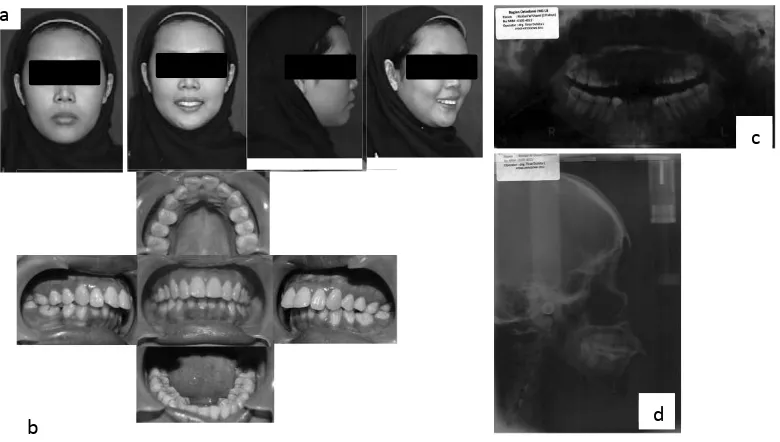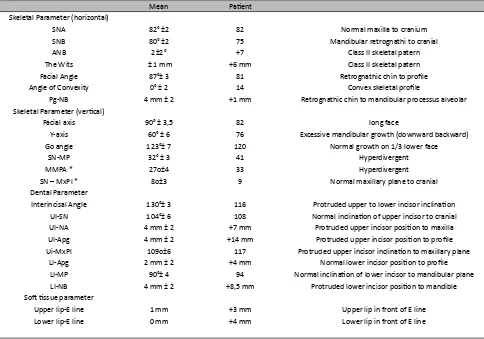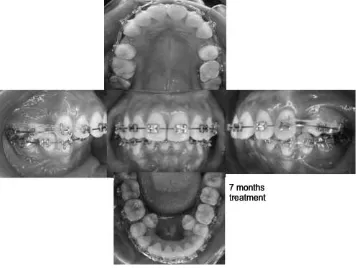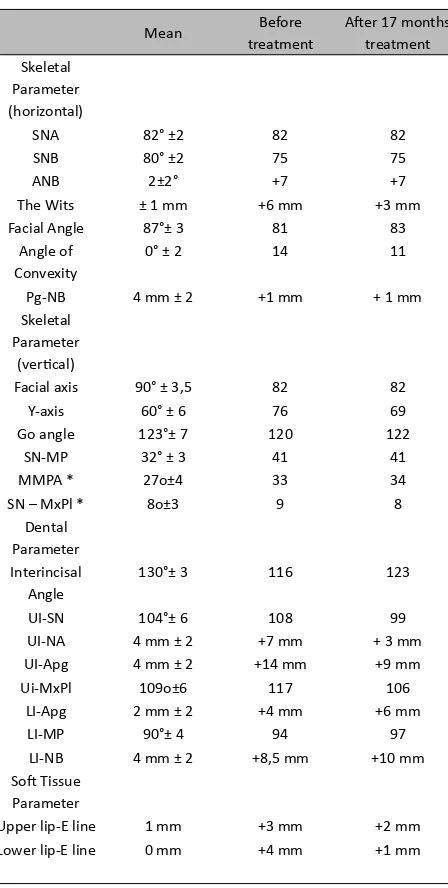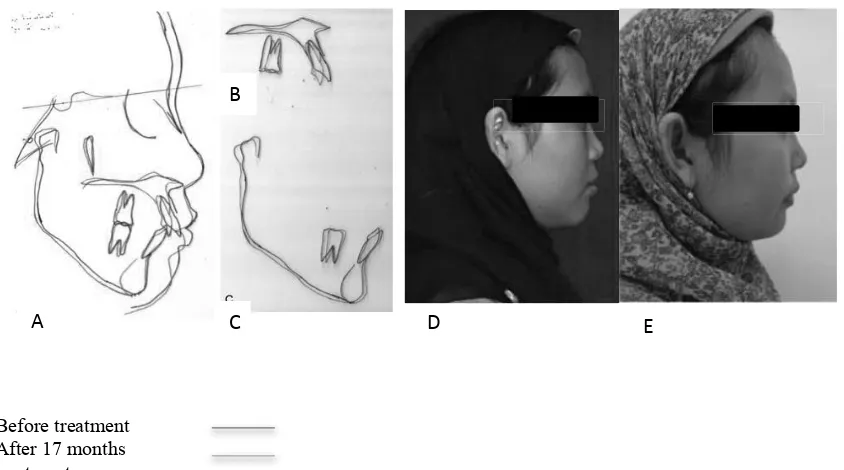Class II division 1 malocclusion with deep Curve of
Spee and lower second premolar linguo version
Tirsa Duhita LaksmihadiaƟ and Erwin Siregar
Department of OrthodonƟ c
Faculty of DenƟ stry, Universitas Indonesia Jakarta - Indonesia
Correspondence: Tirsa Duhita LaksmihadiaƟ , c/o: Departemen Ortodonsia, Fakultas Kedokteran Gigi Universitas Indonesia. Jl. Salemba Raya No. 4 Jakarta 10430, Indonesia. E-mail: Ɵ [email protected]
ABSTRACT
Background: Class II division 1 malocclusion characterized by everted lip, covex profi le, a large overjet, protrussion of the upper incisor, deep overbite and crowding on the anterior teeth. There are several factors can be etiology of deep bite condition with deep Curve of Spee, such as the supraclussion of the upper incisor, large overjet, the size of mesio-distal the anterior teeth, angle of incisor, canine position and infraclussion of the posterior teeth, longer ramus of mandibular, and facial type. Purpose: Correction of deep Curve of Spee, omega shaped mandibular dental arch and to improve the facial profi le. Case: A 27- year old woman with Class II division 1 malocclusion, characterized by a large overjet, a deep overbite with deep Curve of Spee, omega shaped mandibular dental arch because of linguo version lower second premolar, and moderate crowding on upper and lower teeth. She had a convex profi le with a retrognathic mandible and marked lip protrusion. Case Management: Reverse curve archwire was used to correct deep Curve of Spee. Aft er 17 months, ideal overjet, overbite and Curve of Spee were established, and the facial profi le was improved.
Conclusion: Leveling the Curve of Spee by using reverse curve archwire is for uprighting and to extrude the posterior teeth, also
fl aring the lower anterior teeth. This strategy were eff ective to achieve the ideal Curve of Spee, normal overbite and overjet.
Keywords: Deep Curve of Spee; Class II division 1 malocclusion; reverse curve archwire
ABSTRAK
Latar belakang: Maloklusi kelas II divisi 1 memiliki karakter everted lip, profi l cembung, overjet besar, protrusi gigi insisif atas, gigitan dalam (deep bite), dan keadaan gigi anterior bawah berjejal.Terdapat sejumlah faktor penyebab keadaan deep bite dengan kurva Spee dalam, diantaranya supraklusi gigi insisif atas, overjet besar, lebar mesio-distal gigi anterior, angulasi gigi insisif, posisi gigi kaninus, dan infraklusi gigi posterior, ramus mandibula yang lebih panjang, serta tipe wajah dalam arah vertikal. Tujuan: Koreksi kurva Spee yang dalam, lengkung gigi bawah yang berbentuk omega, serta memperbaiki tampilan profi l wajah. Kasus: Pasien perempuan, usia 27 tahun, kasus maloklusi kelas II divisi 1, overjet besar, deep bite dengan kurva Spee yang dalam, lengkung gigi bawah berbentuk omega yang disebabkan oleh gigi premolar kedua dalam keadaan linguoversi, serta gigi atas dan bawah berjejal (moderate). Profi l wajah cembung dengan mandibula retrognati, serta bibir protrusi. Tatalaksana kasus: Penggunaan archwire reverse Curve untuk koreksi keadaan kurva Spee yang dalam. Setelah 17 bulan perawatan, overjet dan kurva Spee ideal telah tercapai, serta ada perbaikan pada profi l wajah. Simpulan: Leveling kurva Spee menggunakan archwire reverse curve bertujuan untuk menegakkan dan memberi efek ekstrusi gigi posterior bawah, juga menghasilkan efek fl aring pada gigi anterior bawah. Strategi ini efektif untuk mencapai keadaan normal kurva Spee, overjet dan overbite.
INTRODUCTION
Class II division 1 malocclusion is characterized by retrognathic mandible look profi le, weak chin,
defi ciency of mandible that gives the illusion of a
large nose, short chin to throat length, obtuse lower lip-chin-throat angle, everted lower lip that wedges behind the incisors, oft en an upper lip that appears short, curled and protrusive, acute labiomental fold, and increased facial contour angle (convex profi le). Dental characteristics this malocclusion are
large overjet, an increased overbite, an accentuated curve of Spee, crowding in the mandibular incisor area, tendency for maxillary incisor protrusion and spacing, and Angle Class II malocclusion.1 In class II division 1 malocclusion the lips are typically incompetent owing to the prominence of the upper incisors and/ or the underlying skeletal patt ern. If the lips are incompetent, the patient will try to achieve an anterior oral seal in one following ways, such as circumoral muscular activity to achieve a lip-seal, the mandible forwarding to allow the lips to meet at rest position, the lower lip drawn up behind the upper incisor, and the tongue is placed forwards between the incisors to contact the lower lip, or combination.2
In orthodontic treatment, fi rst premolar extraction
is indication in moderate to severe crowding with more than 4 mm dental discrepancies, to correct anterior proclination, like in class II division 1 malocclusion or class I bimaxillary dental
protrusion, and to retract lower anterior teeth in class III malocclusion. Second premolar extraction can be considered if the teeth is impaction, caries, or has extreme malposition.3
Leveling the Curve of Spee is important in deep bite correction. Accentuated curve of Spee is oft en done due to deep bite condition. In class II malocclusion, curve of Spee is deeper than in normal occlusion.4
Etiology of deep bite with accentuated curve of Spee are supracclusion of upper incisor, large overjet, increased mesio-distal length of anterior teeth, incisor angulation, canine position, and infracclusion of posterior teeth which can reduced molar height, longer mandibular ramus, and facial vertical height.5,6 The purpose of leveling the Curve of Spee by posterior teeth extruding, proclination of the lower anterior teeth, and intruding the upper anterior are non surgery strategy to correct deep bite. Involving the anterior or posterior segment while leveling the accentuated curve of Spee depends on the biomechanical of the treatment.(5-7)
CASE
A 27-year old woman was looking an orthodontic treatment with chief complaint are the upper anterior teeth proclined and misaligned. She was in a good health condition. From extra oral examination (Figure 1-a), this patient had dolicofacial type,
Figure 1. a. Extra oral, b. intra oral, c. panoramic and d. lateral cephalometry radiogram. a
b
c
symetrical and balance face, and also convex profi le.
There were incompetence lips when in relax position and hypertonic muscle on mentolabial angle. From intra oral examination (Figure 1-b), oral hygiene and gingival health was in good condition, no mobility teeth, deep palate and medium tongue. Dental condition showed moderate crowding on the upper anterior teeth, and severe crowding on the lower anterior teeth, lower second premolar was linguoversion, and deep Curve of Spee. Oval shaped on upper dental arch and omega shaped on the lower arch,¼ class III right and left molar relationship, ¼ class II on right canine relationship and ½ class II on left canine relationship, +10 mm overjet, and +6 mm overbite, and 2 mm lower midline shift to the left . Functional examination found clicking on right and left TMJ without pain. There was tongue thrusting swallowing suspect.
Cephalometric analysis (Figure 1-d and Table 1) showed class II skeletal pattern with normal maxilla and retrognathic mandible to cranial, convex skeletal profi le, and hyperdivergent facial growth,
protruded upper to lower incisor inclination, normal inclination of upper incisor to cranial, protruded upper incisor position to maxilla, protruded upper incisor position to profi le, protruded upper incisor
inclination to maxillary plane, normal lower incisor position to profile, normal inclination of lower incisor to mandibular plane, protruded lower incisor position to mandible, upper and lower lip in front of E-line. Panoramic radiogram (Figure 1-c) showed all permanent teeth has erupted, normal alveolar height, fl at alveolar around 38-37, 37-36, 36-35, 45-4,
46-47 teeth.
Lundstrom analysis showed 3,5 mm space defi ciency on the upper arch and 13 mm on the
lower arch. Bolton overall ratio showed 3,3 mm excessive tooth mass on the lower arch, and Bolton anterior ratio showed 2,4 mm excessive tooth mass on the lower arch. Kesling analysis showed space requirement 2 mm on the upper right and left arch, 4 mm on the lower right arch, and 5 mm on the lower left arch. Treatment with extraction was chosen for this case.
Table 1. Cephalometric analysis
Mean PaƟ ent
Skeletal Parameter (horizontal)
SNA 82° ±2 82 Normal maxilla to cranium
SNB 80° ±2 75 Mandibular retrognathi to cranial
ANB 2±2° +7 Class II skeletal patern
The Wits ± 1 mm +6 mm Class II skeletal patern
Facial Angle 87°± 3 81 Retrognathic chin to profi le
Angle of Convexity 0° ± 2 14 Convex skeletal profi le
Pg-NB 4 mm ± 2 +1 mm Retrognathic chin to mandibular processus alveolar Skeletal Parameter (verƟ cal)
Facial axis 90° ± 3,5 82 long face
Y-axis 60° ± 6 76 Excessive mandibular growth (downward backward)
Go angle 123°± 7 120 Normal growth on 1/3 lower face
SN-MP 32° ± 3 41 Hyperdivergent
MMPA * 27o±4 33 Hyperdivergent
SN – MxPl * 8o±3 9 Normal maxillary plane to cranial
Dental Parameter
Interincisal Angle 130°± 3 116 Protruded upper to lower incisor inclinaƟ on UI-SN 104°± 6 108 Normal inclinaƟ on of upper incisor to cranial UI-NA 4 mm ± 2 +7 mm Protruded upper incisor posiƟ on to maxilla UI-Apg 4 mm ± 2 +14 mm Protruded upper incisor posiƟ on to profi le Ui-MxPl 109o±6 117 Protruded upper incisor inclinaƟ on to maxillary plane
LI-Apg 2 mm ± 2 +4 mm Normal lower incisor posiƟ on to profi le LI-MP 90°± 4 94 Normal inclinaƟ on of lower incisor to mandibular plane LI-NB 4 mm ± 2 +8,5 mm Protruded lower incisor posiƟ on to mandible SoŌ Ɵ ssue parameter
This case was skeletal class II relationship with mandibular retrognathic and normal maxilla. Mandibular growth defi ciency caused upper and
lower jaw disharmony, that make the lower anterior crowding and proclination of upper and lower incisor relationship. Premature loss were suspected on 75, 85 teeth due to 36 and 46 teeth mesial drift , and specifi c crowding on second premolar region
(35 and 45 teeth linguoversion). Persistency were suspected on 51, 52, 61, and 62 teeth that caused upper anterior proclination.
CASE MANAGEMENT
Patient problem list were upper anterior proclined with 10 mm overjet, severe crowding on the lower arch and moderate crowding on the upper arch, deep bite with accentuated Curve of Spee, protruded and incompetence lip, and convex profile. Treatment goal were correcting the inclination of the upper anterior teeth, overjet correction, crowding correction, leveling curve of Spee and deep bite correction, achieving class I canine relationship, competence lip and improved profi le The orthodontic treatment with premolar
extraction using straight wire appliance MBT .022 slot was done. Upper fi rst premolar were extracted
after bracket bonding, followed by aligning an leveling, while lower second premolar extraction has been done aft er aligning and leveling on the lower arch. Elastic class II was used for anterior-posterior control. Deep bite corretion with reverse curve archwire for levelling curve of Spee and upper anterior intrussion have done while doing upper anterior retraction. Retention phase with Essix retainer on both arch aft er orthodontic treatment has fi nished.
Orthodontic treatment was started on January 2013. Aligning and leveling on fi rst phase with
.014 NiTi and laceback for anterior control tipping on the upper arch. On the second month (March 2013), upper fi rst premolar had been extracted,
and the aligning and leveling phase has continued with .016 NiTi on the upper arch and .014 NiTi on lower arch, laceback were done on both arch, and lower second molar buccal tube was bonded. Aft er 3 months (Figure 2), aligning and leveling phase has continued with .018 NiTi on upper and .016
NiTi on lower arch. Overjet was found 8 mm on the 4th month (May 2013), and aligning and leveling phase continued with .016x.022 NiTi on upper and .018 NiTi on lower arch. Overjet was 7 mm on the 5th month (June 2013). Curve of Spee haven’t been corrected on the 6th month (Figure 3), and archwire was changed with .017x.025 NiTi on the upper arch and reverse curve archwire .018 SS on the lower arch, ligation and chinchback.
Figure 2. Intra oral feature on 3 months of treatment.
Figure 3. Intra oral feature on 6 months of treatment.
Figure 5. Intra oral feature on 13 months of treatment.
Figure 6. Intra oral feature on 15 months of treatment.
Figure 7. Intra oral feature on 16 months of treatment.
After 7 months (Figure 4), slight canine distalization has started with .017x.025 SS archwire on the upper arch with sliding mechanic. On the lower arch, deep Curve of Spee has corrected with reverse curve archwire and second premolar had been extracted. On the 10th month (November 2013) .017x.025 NiTi was used on the lower arch. Overjet 5 mm was found on the next month (December 2013), and upper canine distalization has fi nished.
Slight rotation on upper left canine and 1 mm space between upper left central and lateral incisors has found, so .018 NiTi archwire used for re-aligning. On the next visit, .017x,025 NiTi was used, ligation
on posterior teeth has been done, powerchain also used to close the upper left incisor spacing. Midline correction on the lower arch has started used .017x.025 NiTi archwire.5 mm overjet found on the 13th visit (Figure 5), but curve of Spee on the lower arch haven’t been fl at. Anterior retraction with
sliding mechanic on the upper arch has started with .017.025 SS archwire. Correction of curve of Spee on the lower arch with .017x.025 SS reverse curve archwire has been done. On the 14th visit (February 2014), there were class I molar relationship on both side, class I canine relationship on the right side, and ¼ class II canine relationship on the left side, and 2 mm space between lower left canine and fi rst
premolar have been found. Anterior retraction and intrussion with .017x.025 SS archwire with Bulls loop and step up has started on the upper arch. Correction of curve of Spee on the lower arch with .017x.025 SS reverse curve archwire was continued.
After 15 months (Figure 6), 4 mm overjet, 2 mm space between lower left canine and first premolar has found and deep curve of Spee has been corrected. Anterior retraction on the upper arch and lower left fi rst premolar mesialization has
been done. On the next visit (Figure 7), overjet was 3.5 mm and the space between lower left canine and
fi rst premolar has been closed. Anterior retraction on
the upper arch has continued with sliding mechanic on .019x.025 SS archwire with crimpable hook and powerchain. After 17 months (May 2014) space closing has been done and the treatment continued to get ideal interdigitation between upper and lower teeth with .019x.025 SS archwires on both arch.
Aft er 17 months treatment (May 2014) on Figure 8, facial profi le has improved with reducing of the
facial convexity and the upper lip looked move backward. Severe crowding on posterior lower arch, deep bite with deep Curve of Spee have been corrected. Space closing phase has fi nished, and there
Table 2. Cephalometric analysis before and aŌ er 17 months treatment
Mean Before treatment
AŌ er 17 months treatment Skeletal
Parameter (horizontal)
SNA 82° ±2 82 82
SNB 80° ±2 75 75
ANB 2±2° +7 +7
The Wits ± 1 mm +6 mm +3 mm
Facial Angle 87°± 3 81 83
Angle of Convexity
0° ± 2 14 11
Pg-NB 4 mm ± 2 +1 mm + 1 mm
Skeletal Parameter
(verƟ cal)
Facial axis 90° ± 3,5 82 82
Y-axis 60° ± 6 76 69
Go angle 123°± 7 120 122
SN-MP 32° ± 3 41 41
MMPA * 27o±4 33 34
SN – MxPl * 8o±3 9 8
Dental Parameter Interincisal
Angle
130°± 3 116 123
UI-SN 104°± 6 108 99
UI-NA 4 mm ± 2 +7 mm + 3 mm UI-Apg 4 mm ± 2 +14 mm +9 mm
Ui-MxPl 109o±6 117 106
LI-Apg 2 mm ± 2 +4 mm +6 mm
LI-MP 90°± 4 94 97
LI-NB 4 mm ± 2 +8,5 mm +10 mm SoŌ Tissue
Parameter
Upper lip-E line 1 mm +3 mm +2 mm Lower lip-E line 0 mm +4 mm +1 mm
DISCUSSION
Upper anterior proclined and crowding are major complain on this case. From extra oral and intra oral photo, study model, panoramic and lateral Figure 8. Intra oral, extra oral condiƟ on, panoramic and lateral
cephalometric radiogram, it was concluded that this case was a class II division 1 malocclusion with retrognatism mandible, deep bite, convex profi le,
incompetence lip and hypertonic on mentolabial angle. Class II division 1 malocclusion was characterized with upper incisor proclined which cause the large overjet and accentuated curve of Spee with deep overbite.1,2,4,8-10 Dental aspect showed class II division 1 incisor relationship with crowding or spacing on the upper anterior teeth. Crowding dental arch and insufi cient space on dental arch
cause incisor crowding and larger overjet.2 Longer dental arch on the upper arch usually due to incisor proclined.11 In this case, mild crowding on the upper arch caused longer upper dental arch and larger overjet. Severe crowding on the lower arch caused collaps of lower dental arch with omega-shape dental arch, so the lower dental arch was shorter than upper dental arch. Large overjet (9-10 mm) was become major complain for this patient because of esthetically worst and the patient had diffi culty to close her lips (lip incompetence on relax condition). Facial proportion on vertical aspect showed 1/3 lower face longer (long face type), due to skeletal condition. Tongue thrusting swallowing habit on this patient was occurred due to achieving the lip seal because of large overjet and the skeletal condition.
Molar relationship usually refl ects the skeletal
condition (class II skeletal), except on premature loss deciduous teeth which cause mesial drift of lower permanent molar, and the molar relationship is class I.2 In this case, the molar relationship were class III with mesial tipping, and severe crowding on lower posterior region (lower second premolar linguoversion). Premature loss on lower deciduous posterior teeth are suspected, because there was mesial drift of the lower permanent molar and there was insufi cient space for lower second premolar
to erupt. Upper fi rst premolar extraction has done
to correct upper incisor proclination and reduce overjet, so the profi le convexity can be reduced. First
premolar extraction is indicate in several condition such as more than 4 mm space requerement case on moderate to severe crowding, for correcting proclined anterior teeth like in class II division 1 or class I bimaxillary dental protrussion malocclusion, and to retract lower anterior teeth on class III malocclusion. First premolar extraction can add more anchorage unit in en masse retraction.Second premolar extraction can be choosed on impaction condition, bad caries and extreme malposition, or if several posterior mesialization are needed.3 In this case, upper fi rst premolar has been chosen
because of moderate crowding on the upper arch, and the space was used to correct upper anterior
Before treatment After 17 months treatment
E D
A
B
C
proclination to achieve bett er profi le. Lower second
premolar extraction has been chosen because of those extreme malposition (linguoversion) and lower posterior mesialization was needed to achieve a normal overjet.
Camoufl age orthodontic treatment has been done
to correct overjet, deep bite, deep curve of Spee, and crowding on both arch. Correction of the deep bite and deep curve of Spee has achieved by extrude the premolar teeth, uprighting mesial tipping lower fi rst
molar and fl aring lower anterior teeth. Correction
of the deep Curve of Spee has started on initial aligning-levelingphase with small NiTi archwire, then continued by reverse curve archwire. Reverse curve archwire can make lower incisor proclined and extrude lower posterior teeth to achieved a fl at
curve of Spee and give a good longterm stability.6,12 In this case, the proclined lower incisor is also used to achieve a normal overjet.
Aft er 17 months of orthodontic treatment, normal overjet (3 mm), overbite (2 mm), fl at curve of Spee
had achieved, and crowding on both arches has been corrected. Class I molar relationship on both side, class I canine relationship on the right side and ¼ class II canine relationship on the left side, lower first molar was more upright, and better interdigitation has achieved. Major complain of this patient has been corrected, bett er profi le has
achieved and facial convexity and proclination of the upper lip has reduced (fi gure 9-D, E). Lateral
cephalometric radiogram analysis (table 2) showed the proclination of the upper to lower incisor has reduced (116o– 123o). Upper incisor to SN angle and to maxillary plane has reduced (UI-SN 108o before and 99a aft er treatment and UI-MxPlane 117o before and 116o aft er treatment). Lower incisor looked more proclined (Li-MP 94obefore and 97o aft er treatment), but it can be tolerated and still in a good esthetic. Vertical skeletal parameter showed no signifi cant diff erence, only Y-axis has a signifi cant
diff erence (76o before and 69o aft er treatment). This condition might be caused by extrusion of the lower posterior teeth as the reverse curve archwire eff ects, which cause clockwise rotation of mandible (backward and downward rotation). Lateral cephalometric radiogram before and aft er 17 months treatment superimposition to SN plane (fi gure 9-A) showed backward movement on the
upper lip, and the profi le convexcity has reduced,
also bett er profi le has achieved. Almost treatment
goal has achieved aft er 17 months treatment and major patient complain has been corrected.
This class II division 1 malocclusion case was treated by camufl age orthodontic treatment with
premolar extraction to correct overjet, deep bite, deep curve of Spee, and crowding on both arch. Lower second premolar extraction has been choosed because of those extreme malposition (linguo version). Upper fi rst premolar extraction has been
choosed to correct procline upper anterior teeth and to improve soft tissue profi le. Correction of deep
curve of Spee using reverse curve archwire are by uprighting and extrude the lower posterior teeth, and by fl aring lower anterior teeth. Those eff ects are
eff ective to achieved normal curve of Spee, normal overjet and overbite. Major complain of this patient has been corrected. Better profile has achieved, facial convexcity and proclination of the upper lip has reduced.
REFERENCES
1. Reyneke JP. Essentials of orthognathic surgery. Carol Stream: Quintessence Publishing Co; 2010. p. 1-7. 2. Mitchell L. An introduction to orthodontics. 3rd ed. New
York: Oxford Press; 2007. p. 8-9, 78-81, 100-9.
3. McReynold DC, Litt le RM. Mandibular second premolar extraction: post retention evaluation of stability and relapse. Angle Orthod 1992; 61: 133-45.
4. Shannon KR, Nanda RS. Changes in the curve of Spee with treatment and at 2 years posttreatment. Am J Orthod Dentofacial Orthop 2004; 125: 589-96.
5. Parker CD, Nanda RS, Currier GF. Skeletal and dental changes associated with the treatment of deep bite malocclusion. Am J Orthod Dentofacial Orthop 1995; 107(4): 382-93.
6. Nanda R. In: 1st, editor. Biomechanics and esthetics strategies in clinical orthodontics. St Louis: Elsevier; 2005. p. 131-5.
7. Nanda R. Current therapy in orthodontics. St Louis: Elsevier; 2010. p. 186-97.
8. Proffi t WR. Orthodontic diagnosis: The problem-oriented approach. In: Proffi t WR, Sarver DM, Ackerman JL, editors. Contemporary orthodontics. 5th ed. St Louis: Mosby Elsevier; 2013. p. 176-84.
9. Proffi t WR. Contemporary orthodontics. 4th ed. St Louis: Mosby Elsevier; 2007. p. 158-60.
10. Steadman R. Overbites. Angle Orthod 1940; 10: 148-54. 11. Da Silva OG, Ferrari FM, Ozawa TO. Dental arch
dimensions in class II division 1 malocclusions with mandibular defi ciency. Angle Orthod 2008; 78(3): 466-74.
